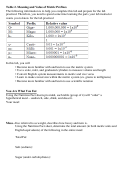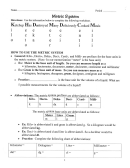Real World Metric System
ADVERTISEMENT
Real World Metric System
Each table has been given a Nutrition Facts sheet from a well-known fast food restaurant.
Notice that serving sizes and quantities of fats, sugars, etc. are listed using “grams (g)” or
“milligrams (mg)”. These are units of measure in the International System of Units,
commonly called the metric system. The metric system is the only system of measurement
used in most countries worldwide and in science. In the United States, we tend to use the
English system of measurement, for example ounces or pounds. Since all measurements
throughout your scientific career should be stated in metric system units, this lab will serve to
introduce you to the metric system, and how to convert English system units to those of the
metric system.
The metric system is easy and convenient to use. Table 1 lists some common metric units of
measurement and their English system equivalents. Notice that within each category the units
vary by powers of 10, which makes conversion from one unit to another very easy within the
metric system. Table 2 lists the relative value of commonly used prefixes in the metric
system. Table 2 also lists those relative values in scientific notation. Scientific notation is
commonly used in science as a type of short-hand when dealing with very small or very large
numbers. Notice that the exponent number is the number of decimal places either after (for
large numbers a positive exponent) or before (for small numbers a negative exponent) the
base unit.
Table 1. Some important details about the metric system.
The following information is to help you complete this lab and prepare for the lab practical.
Therefore, you need to spend some time learning the parts your lab instructor wants you to
know for the lab practical.
ADVERTISEMENT
0 votes
Related Articles
Related forms
Related Categories
Parent category: Miscellaneous
 1
1 2
2 3
3 4
4 5
5








